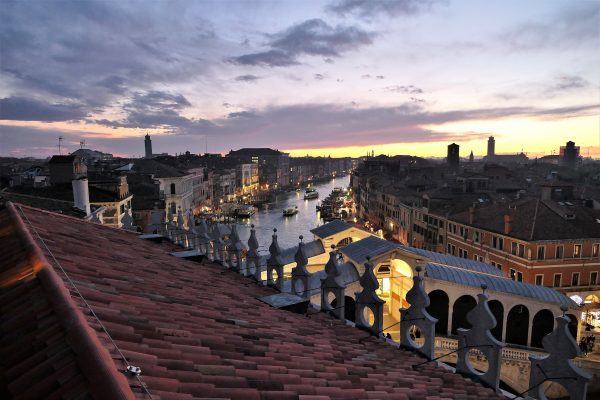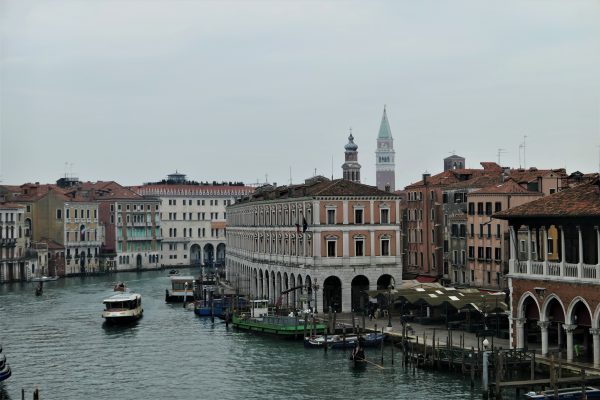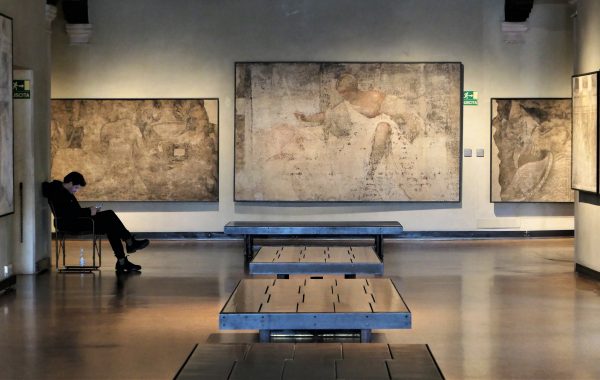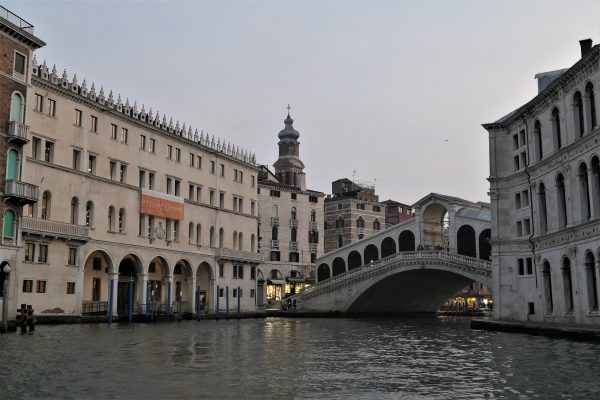With its iconic bridge and elegant architecture, the Rialto district of Venice is steeped in history. Joe Gartman tells the story of Fondaco dei Tedeschi with images by Patricia Gartman
Sunset view over the Rialto Bridge to Grand Canal from the roof of Fondaco dei Tedeschi
It may be on a spring day, when the faded facades of old palazzi are reflected in the gently flattering mirror called the Grand Canal; or an autumn evening, when San Giorgio Maggiore and Santa Maria della Salute are silhouetted against a gold-orange sunset; or a winter noon, when the morning fog lingers like an insensitive guest on the Fondamente Nove, and the vaporetti are delayed “causa nebbia”; or even perhaps in summer, when a glass of prosecco and a spot of shade are contentment enough – but someday, we’ll find ourselves back in Venice, you and I.
And then, away from the clamour of Piazza San Marco, along some small canal, Venice will fold us in her quiet embrace. As before, there’ll be no cars, no buses, no trams, not even a bicycle. Serenity will reign, despite the low mutter of an occasional outboard motor.
La Serenissima, it’s called, this watery city that has been sinking slowly into the Adriatic for 1,500 years. Despite wars and plagues and intrigues, Venice’s political stability was remarkable, compared to the rest of the Italian peninsula, in the centuries between the collapse of the Western Roman Empire and the day that Vasco da Gama turned the corner at the Cape of Good Hope and sailed for India. After that, Venice no longer was the only conduit for trade with the East, and life became a bit complicated.
View from Ca’ d’Oro with the Fondaco dei Tedeschi partially obscured by the Fabbriche Nuove building near the Rialto Market
But let us concentrate on the heady days of power and affluence, and ignore the slow decline that followed. And what better way than to pay a visit to the Ca’ d’Oro, the “Golden House” on the Grand Canal, built in the 1440s for Marino Contarini, Procurator of San Marco? The delicate marble columns and traceries of the first and second floor loggias, once edged in gold, made this palazzo the most famous example of Venetian Gothic architecture in the city, and a symbol of Venice’s graceful splendour.
Inside, we’ll find a splendid art collection, including a St. Sebastian by Mantegna, and several large, detached frescoes painted by Titian and Giorgione. The frescoes are badly weathered and barely recognizable, but they are very evocative of history, as we shall see. For now, though, we’ll find our way to the second floor loggia, from which we’ll have a superb view of the Grand Canal, as it winds southwest around the Rialto Mercato on the flank of the San Polo district.
Detached fresco by Titian, in the Ca’ d’Oro, from Fondaco dei Tedeschi façade with Goddess Venetia as Justizia
We won’t see the Rialto Bridge, which is obscured by the 16th century Fabbriche Nuove building; but we will see, across the canal, half of an enormous, rather plain structure, with a red roof and a row of arched landing stages. It’s difficult to imagine, but this building was once the tollbooth for all of Venice’s trade with northern Europe; it also once rivalled the Ca’ d’Oro for splendour of decoration – because the detached fragments of fresco here in the “Golden House” are all that’s left of the original facades, front and sides, of the Fondaco dei Tedeschi, the “German Trading House”.
In that building, merchants from Flanders, the Hanseatic League cities, and south to Poland lived, traded, and stored their merchandise under the watchful eyes of the Venetian tax collectors. Furs and precious stones, leather, gold and silver came from the north, and were traded for silks, velvet, exotic spices, glass and other luxuries from Asia; and both the merchants and the Venetian Republic profited handsomely for centuries.
Rialto Bridge and Fondaco dei Tedeschi, with the bell tower of San Bartolomeo di Rialto beyond
When, in Shakespeare’s Merchant of Venice, Salanio asks his friend Salarino “What news on the Rialto?”, he is inquiring about a merchant ship that may have been lost at sea. Such an occurrence would have been a hot topic in the Rialto, the business and banking district of Venice since the 11th century. The famous bridge connects the original Rialto, on the San Polo side of the canal, with the newer Rialto in the San Marco district, which became prominent when the Fondaco dei Tedeschi was first built in 1222. In 1505, the Fondaco burned to the ground, but was quickly rebuilt, bigger and more impressive than before, with a large inner courtyard surrounded by three levels of galleries supported by one hundred forty arches. It was home, showroom, and warehouse for more than a hundred foreign traders.
As trade declined in the 17th century, the building fell into disrepair. The “German” merchants moved out after the Venetian Republic fell in 1797; and under Napoleon’s rule and the Austrian occupation, most decorations and furnishings were sold or stolen or otherwise lost. After 1870, the new Kingdom of Italy used the Fondaco for a series of government offices, and finally as the main Post Office under Mussolini. In 1938, the nearly unrecognizable frescoes by Giorgione and Titian were removed.
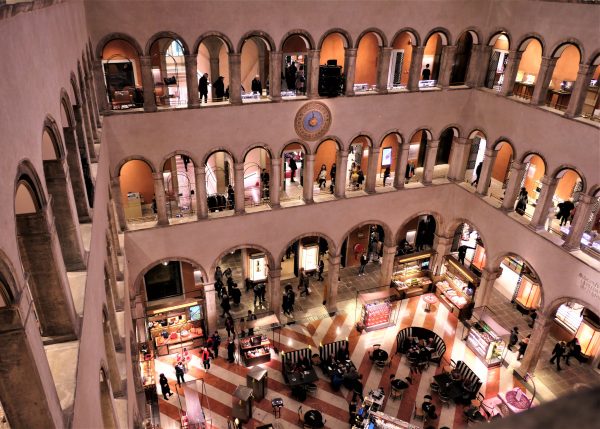 Interior of Fondaco dei Tedeschi restored as a luxury shopping centre called T Fondaco by DFS
Interior of Fondaco dei Tedeschi restored as a luxury shopping centre called T Fondaco by DFS
The Post Office was acquired by the Benetton Group in 2010, and renovated in 2016 as a luxury shopping centre. The entrance is near the eastern end of the Rialto Bridge. Inside, no doubt we will find furs and precious stones, silks, velvet and even perhaps rare spices, just as of old; but let us instead take the ultra-modern lift to the top floor, and walk out on the roof at sunset for a glowing panorama of the city. We’ll watch the boats plying the shining water of the Grand Canal, and wonder how the sober, practical merchants and bankers of the Rialto came to finance a city that rises like a dream from the water, and after plagues, fires, floods and pestilence, still touches our hearts like poetry.

